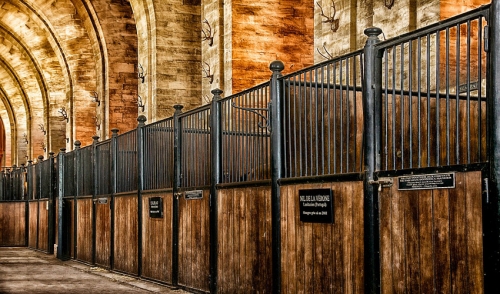Having rubber stall mats offers your barn and stables a more efficient way of managing your horse. The firm surface of any rubber stall mat makes it easier to clean up manure, soiled bedding, and can reduce the amount of bedding you currently use saving you time and money.
A rubber stall mat provides your horse with a healthy surface for the horse to stand on. When the surface of the floor beneath the horse’s feet is level and firm, it can protect the horse against possible joint issues and other injuries. If you’re a horse owner that needs his horses to be at 100% year-round, then horse mats are for you. They not only create a level and firm surface, the rubber also provides the horse with a small cushioning effect that can lead to healthier and happier horses than an uneven, damp, hard stall surface. The advantages to the owner by using horse mats could not be greater. The cost of your bedding will drop, you will need less storage area, and less time spent doing chores and cleaning after the horses. The most difficult part about owning rubber stall mats may just be installing them.
Before you can begin installing rubber stall mats, you will need to gather the right supplies. If your stalls are bare you will need crushed rock to fill the stall area. If your floors are already cemented, then you are already off to a good start. Once the floors are level make sure you have enough stall mats to fill the appropriate space as well as a carpenters knife to cut corners as need be. Finally you will need a straight edge, tape measure, chalk, carpenter’s level, and a hand compactor to get the mat properly installed into the space.
If you’re stalls are already cemented then you go ahead and proceed to lay the mats. If not stick a block of wood in the doorway of the stall and spread gravel until its level in the space and reaches the top of the 2x4 used inside the stall doorway. Using a garden rake or your hands, smooth out the gravel and confirm there are no soft spots. Throughout the entire installation use the carpenter’s level to check the accuracy of your work. Use the hand compactor to compact the gravel below the desired finish line. When you are ready to lay the mats, keep in mind that you want to minimize the amount of cuts you have to make. Avoid using small pieces to fill in gaps as it can weaken the surface and decrease the durability of the mat. One good tip is to take measurements of each stall before installation and again right before. Try to lay all mats so they do not require cutting and use vice grips to fix them in a nice, snug position against each other. When ready, use the utility knife and straight edge to make custom cuts as necessary.
Once the mats are snug and secure your job is done. The hardest part about installing rubber mats is making sure the measurements are appropriate and the surface is properly leveled. If you have any trouble contact a professional installer. Professional installers are also very helpful for larger barns. For a smaller barn, you can definitely do the installation yourself saving you even more money and the rewards of a hard day’s work.






Comments